* (restored)
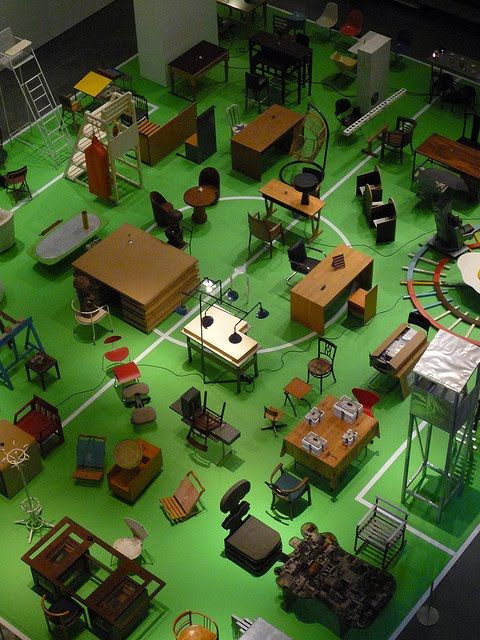
Since I first saw his work back in my student days, the German artist Martin Kippenberger has been a big influence on me. I was always sympathetic enough to his fabled ‘bad boy’ persona but the art itself has a specific tone, a brand of humour that I find key, and as a student poring over his oeuvre in the art school library I felt I’d found a kindred spirit. In 2006, a couple of years after graduating, I took the train down to London with my Mum to see the Kippenberger retrospective at Tate Modern. That show included his magnum opus, the 1994 installation The Happy End of Franz Kafka’s ‘Amerika’, which is an overwhelming, dizzying experience. I hope this Day can manage to give a sense of it.

Martin Kippenberger (25 February 1953 – 7 March 1997) was a German artist known for his extremely prolific output in a wide range of styles and media, superfiction as well as his provocative, jocular and hard-drinking public persona.

The Happy End of Franz Kafka’s ‘Amerika’ (1994) explores the fictional utopia of universal employment, adapting Kafka’s idea of communal job interviews into an artwork. The installation consists of a diverse assortment of objects and furniture, assembled to suggest a playing field for conducting mass interviews. There are over 40 tables and twice as many chairs, from classics of twentieth-century design, such as chairs by Arne Jacobsen and Charles Eames, to worn-out tables bought in flea markets, remnants of previous Kippenberger exhibitions, and even work by other artists.
https://en.wikipedia.org/wiki/Martin_Kippenberger
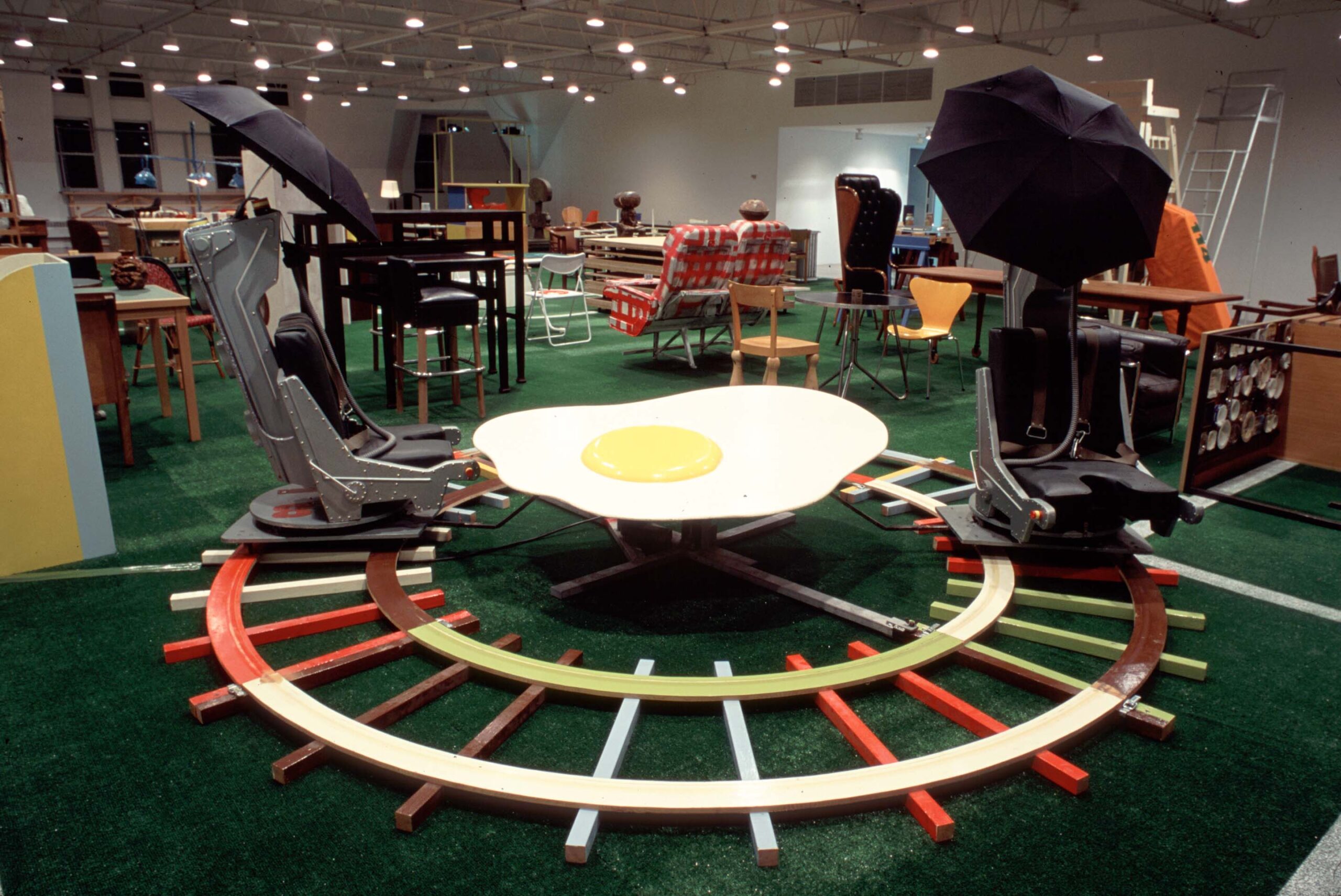
Based on Kafka’s novel ‘Amerika’, Kippenberger re-imagines the final scene of the unfinished book and suggests an alternative ending. At this point in the story the lead protagonist Karl Rossmann (after traveling across America) applies for a job at ‘the biggest theater in the world’ where ‘every one is welcome’ and ‘whoever wants to become an artist should sign up!’ Claiming that he also never finished reading the book, Kippenberger approaches the unfinished condition of the novel as an open possibility for an uncharacteristically ‘happy ending’.
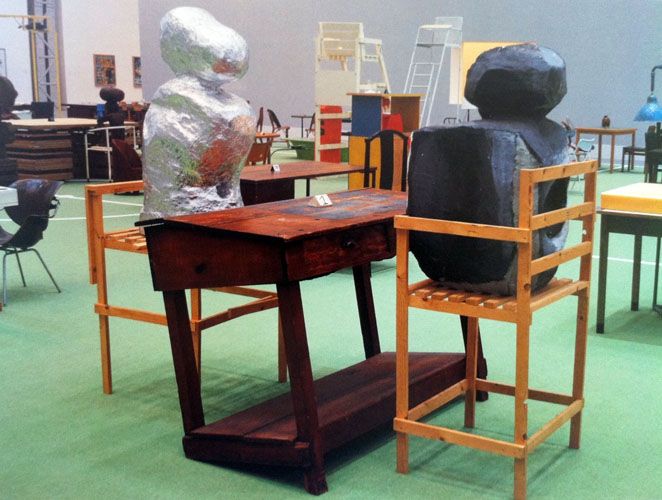
The wide variety of tables and chairs present an abundance of possible meanings and outcomes for Karl Rossmanns interview at the theater, whilst suggesting a range of personalities and psychological types. Although an installation, the work becomes a comment on the importance of communication, relationships and dialogues. Fundamentally the social processes involved in an artistic practice.
Jack Brindley
http://openfileblog.blogspot.co.uk/2011/03/martin-kippenberger-happy-end-of-franz.html

Kippenberger wanted to supply a happy ending to Franz Kafka’s unfinished novel, Amerika. The Kippenberger solution took the form of a sprawling installation, which provides the high point of the Tate Modern retrospective. An arrangement of about 50 chairs and tables stands on a green mat imprinted with the lines of a football pitch. The assorted furniture – including 20th-century design classics, chairs and tables “adapted” by other artists as well as refashioned by Kippenberger himself – is arranged as though for interviews. In Kafka’s novel, the protagonist applies for a job advertised at “the biggest theatre in the world”. “Whoever wants to become an artist should sign up,” the advert invites.
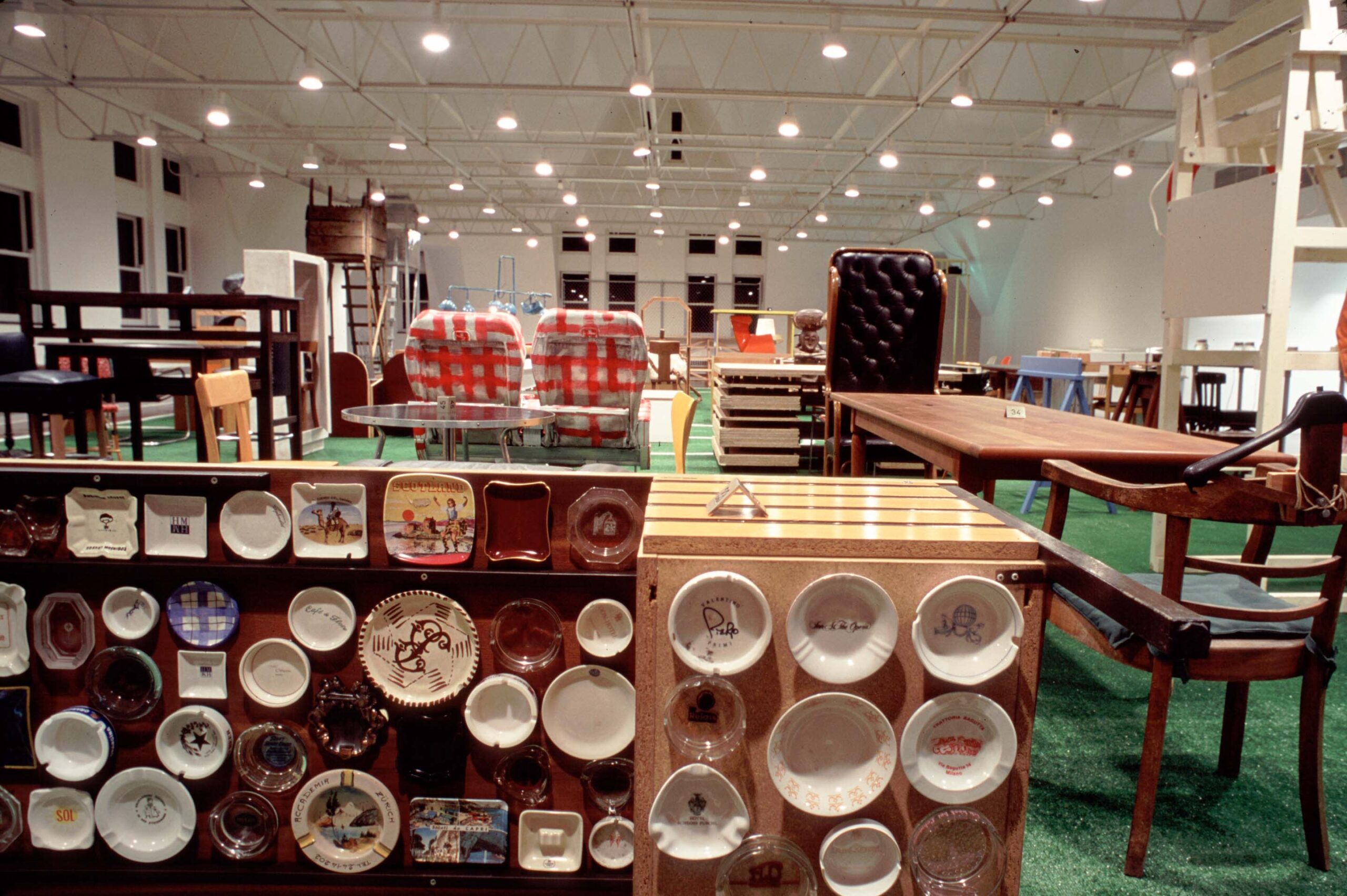
Kippenberger’s desks and chairs are implausible, uncomfortable settings, each a sculptural tableau in its own right. There are Eames chairs and Jacobsens, a table set with jars of body parts (on which filmed talking heads by artist Tony Ousler are projected), chairs set with African carvings, desks with Kippenberger’s own paintings stashed underneath, a metal table rimed in thick paint and gloopy silicon. Standing amid it all are rickety, concentration-camp-style watchtowers and a lifeguard’s tower. Unfortunately, viewers won’t be able to wander within the installation, but will have to be content to observe from the stadium bleachers at either side, like spectators at the big game.

Most alarming of all are the motorised ejector seats that whir perilously around a circular track, in orbit of a gigantic model of a fried egg. It is all, of course, a model of the art world, but it looks like a torture garden. I imagine Nicholas Serota and Tate Modern director Vicente Todoli strapped in, being whirled around at unimaginable G-forces. I think Kippi would have liked that. It would have made a Happy End.
Adrian Searle
http://www.theguardian.com/culture/2006/feb/07/2

Kippenberger and the MOMA show make the best cases for themselves with “The Happy End of Franz Kafka’s ‘Amerika’ ” (1994), a vast installation in the museum’s atrium. The work represents the recruitment center for the Nature Theatre of Oklahoma, where Kafka’s immigrant hero applies for work, as a warren of office furniture and bizarre objects on an abbreviated soccer field. There are thrift-store and classic modern chairs (an Eames, a Gehry), similarly miscellaneous lamps, concentration-camp and lifeguard watchtowers, and a carrousel of two cockpit ejector seats around a sculpture of a fried egg. Bleachers are provided from which we may gaze our fill at nothing happening. It makes stirring sense for Kippenberger, a paladin of uncalled-for gestures, to identify with the disconcertingly upbeat “Amerika,” so at odds with Kafka’s signature tales of dread. I can think of few other artists so richly deserved by their times. For that very reason, whenever I go to contemplate a contemporary art work for pleasure, it will not be a Kippenberger.
Peter Schjeldahl
http://www.newyorker.com/magazine/2009/03/09/taking-a-toll
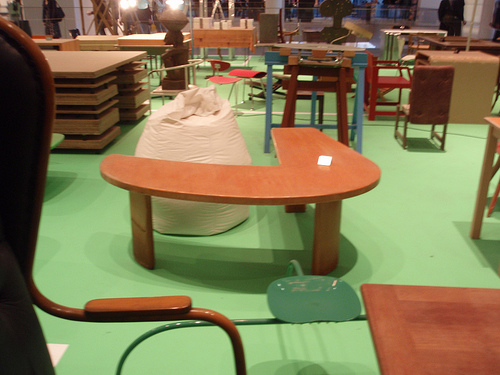
At the centre of gravity of Kippenberger’s oeuvre is the installation organized around a closed book, ‘The Happy Ending of Franz Kafka’s Amerika’ (1994). Notoriously, Kippenberger never finished his reading of Kafka’s novel, but relied on a colleague’s account of the closing chapter. In some ways, this is entirely appropriate, since Kafka did not finish his work on the text, and in any case, he had not visited the settings he described, fabricating an America of the imagination based on received ideas of the United States. The vast array of chairs and tables that predominate in the installation recalls the scenario in Kafka’s immense ‘Nature Theatre of Oklahoma’, where the offer of total employment involves a series of humiliating job interviews. Kippenberger’s simulation of a received version of Kafka is inflected by the recent history of the movement of labour and the ubiquity of immigration centres, all organized ultimately around the interview situation. If the twentieth century starts with Manhattan as the location for the imagined opportunities of economic migration, it ends with the cross-border traffic of Kippenberger’s Europe, in which one interview leads to another in a process that involves the re-making of the self as a permanent condition. Whether this condition has the potential for reanimation or diminution is clearly an open question: the ‘happy ending’ has not yet been written.
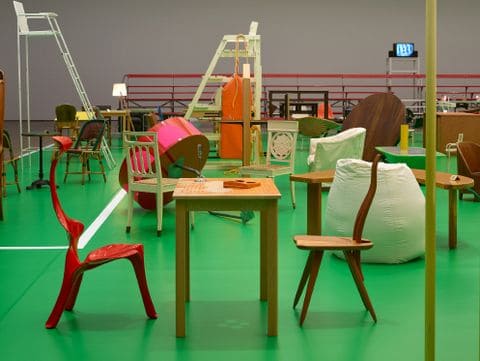
Postmodern desire is for received ideas of the desirable, relayed mechanically by a culture industry whose keenest observer and most tenacious parasite was the incorrigible Martin Kippenberger.
Rod Mengham
http://magazine.saatchiart.com/articles/the_incorrectness_of_martin_ki
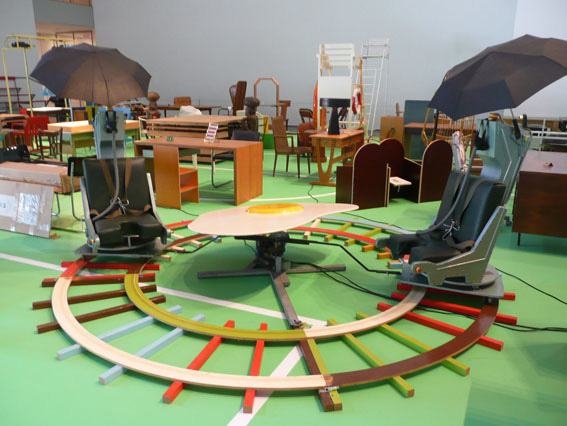
Although most of Kippenberger’s oeuvre tends toward the creation of a vast, interconnected artwork, The Happy End of Franz Kafka’s ‘Amerika’, 1994 is unique in that it might be considered his masterwork and the culmination of his achievement. Based on Kafka’s novel Amerika, the installation re-imagines a section of the book when the protagonist Karl Rossmann, having travelled across America, applies for a job at the ‘biggest theatre in the world’. ‘Everybody is welcome!’ proclaims the call for employment, ‘Whoever wants to become an artist should sign up!’. Kafka never completed the novel, which he abandoned writing over ten years before it was posthumously published in 1927, and Kippenberger claimed that he never finished reading it, hearing the story second-hand from a friend. The unfinished condition of the book leaves open the possibility, unusual in Kafka’s fiction, for a ‘happy ending’.
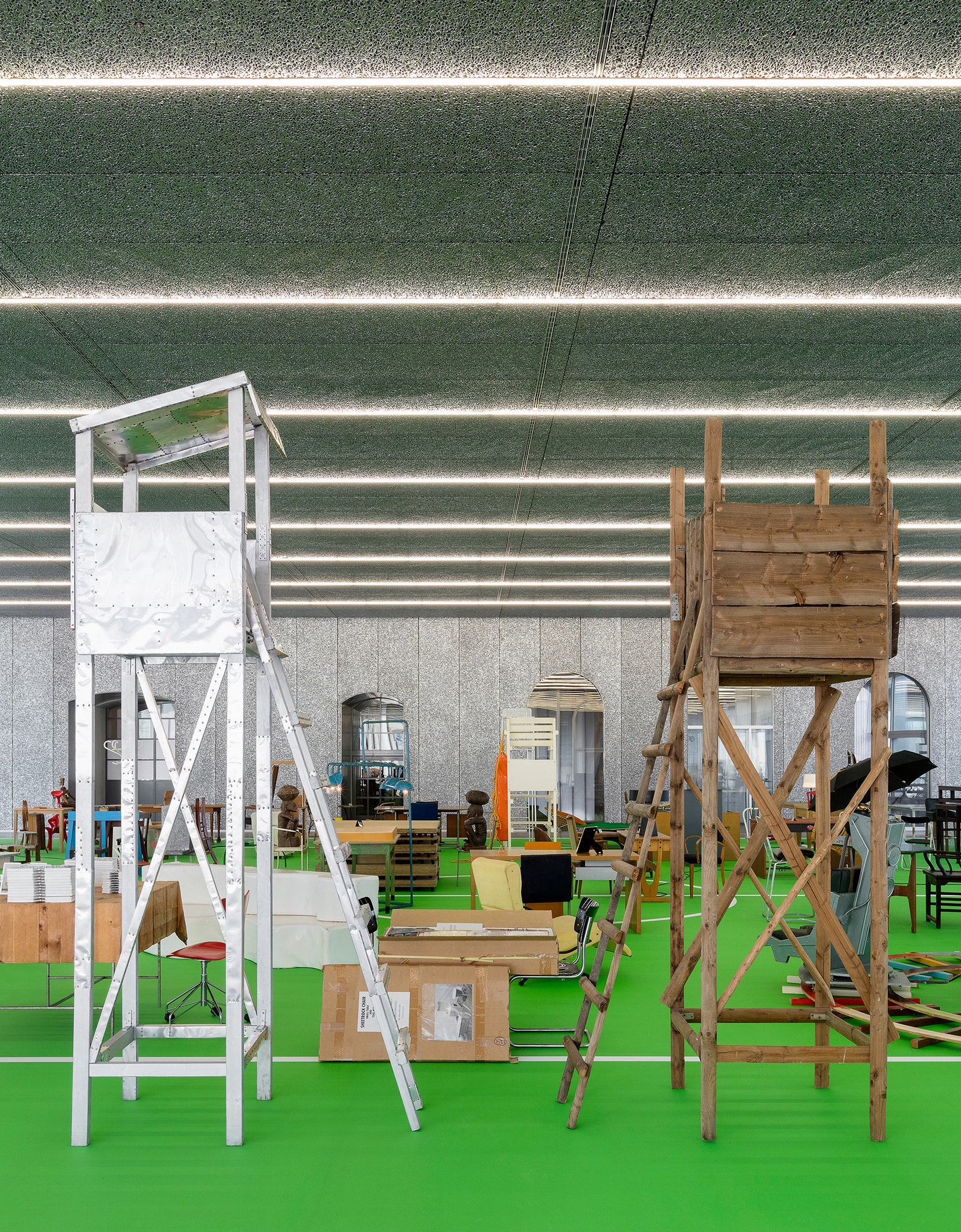
The Happy End of Franz Kafka’s ‘Amerika’ explores the fictional utopia of universal employment, adapting Kafka’s idea of communal job interviews into an artwork. Kippenberger described the situation depicted in his installation as ‘a circus in town, looking to employ reliable hands, helpers, doers, self-confident handlers and the like. Outside the circus tent, in my imagination, there would be tables and chairs set up for job interviews’. The installation consists of a diverse assortment of objects and furniture, assembled to suggest a playing field for conducting mass interviews. There are over 40 tables and twice as many chairs, from classics of twentieth-century design, such as chairs by Arne Jacobsen and Charles Eames, to worn-out tables bought in flea markets, remnants of previous Kippenberger exhibitions, and even work by other artists.
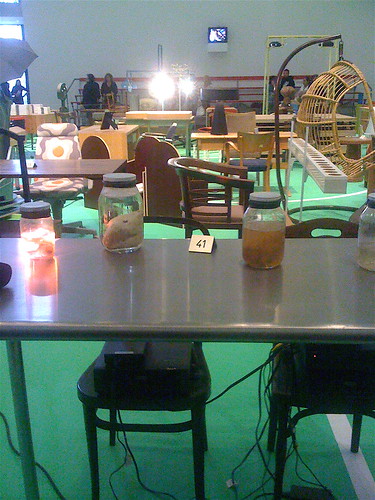
The Happy End of Franz Kafka’s ‘Amerika’ is Kippenberger’s most complex work, presenting the viewer with an overabundance of possible meanings. At one level, the installation refers to the competition between artists and constant judgements within the art community. Yet the variety of furniture also suggests a range of personalities and psychological types, and the interview format reflects the artist’s belief in the fundamental importance of relationships and dialogues.
Jessica Morgan
http://www.tate.org.uk/whats-on/tate-modern/exhibition/martin-kippenberger/martin-kippenberger-room-guide-introduction-6

In Martin Kippenberger’s epic installation The Happy End of Franz Kafka’s ‘Amerika’ (1994) a roomful of unmatched desks and chairs are arranged on a green sports ground, with bleachers on each end. The piece takes its title from Kafka’s unfinished last novel from 1927, which ends with its protagonist applying for work at the Nature Theatre of Oklahoma after reading an advertisement stating: ‘Whoever wants to be an artist should sign up’. Kippenberger’s installation was an effort to complete Kafka’s work without fixing it to a single narrative; each desk represents a job interview, to be carried out by Kippenberger and his colleagues, collected and published. The Happy End… is a concept, but it also signifies a performance, of every job applicant and every artist, and the capacity to reinvent the same subject with each performance.
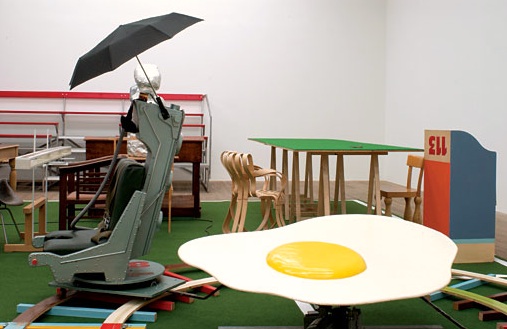
Although viewers were kept off the actual ‘Amerika’ installation, the bleachers allowed access to the imaginary interviews. From a distance the absurdity of the process, and of those repressive cultural conventions that engender it, begins to focus. From the laughter of the condemned comes, always, the funniest joke.
Natalie Hatted
http://www.frieze.com/issue/review/martin_kippenberger3/
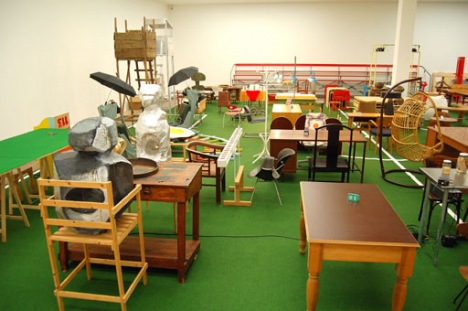
Kippenberger’s late masterpiece The Happy End of Kafka’s Amerika takes the modern working world as its subject. In the unfinished Franz Kafka novel Amerika (or The Man Who Disappeared) the protagonist is looking for work. The poster that leads him to an absurdist interview taking place on a grand scale reads, “At the racecourse in Clayton, today from 6 a.m. till midnight, personnel is being hired for the Theatre in Oklahoma! The great Theatre of Oklahoma is calling you! It’s calling you today only! If you miss this opportunity, there will never be another! Anyone thinking of his future, your place is with us! All welcome! Anyone who wants to be an artist, step forward! We are the theatre that has a place for everyone, everyone in his place! If you decide to join us, we congratulate you here and now! But hurry, be sure not to miss the midnight deadline! We shut down at midnight, never to reopen! Accursed be anyone who doesn’t believe us! Clayton here we come!”

In Kafka’s work interviewers evaluate interviewees in an expansive environment. We know that the questions do not regard whether the potential worker has pursued a work which will clear a space for play which will lead to freedom. We know the questions are of the kind determining whether the potential worker will be of the sort that will suit the needs of the interviewer. Kafka’s protagonist makes the claim of being an engineer just to get the process over with. So here Kippenberger creates a sculpture that presents a seemingly endless array of interview tables and chairs–not at a racecourse but on a soccer pitch–and this diversity, a wild diversity shared by all the work’s constituting elements, is itself a demonstration of play, a demonstration of freedom, which takes as its subject not enforced servitude but voluntary servitude. Some freedom is not only work but revolt.

To make the association of work with servitude or bondage clear, Kippenberger has placed on the edge of the sports field observation towers of the kind one would find in a prison or concentration camp. The towers emphasize that there is a direct relationship between the enforced servitude of the concentration camp and the voluntary servitude of the workplace. Work will not set you free if it is not your work.

Not only do the disparate designs for the chairs and tables (some found junk, some design classics, some hand made, some made by other artists–Tony Oursler and Jason Rhoades included) suggest a subversion of the standardized interview process so does the very design of the field. The use of the sports field as the ground for the sculpture emphasizes that there are rules to the game of servitude and Kippenberger’s work insists on directing our attention to the absurd rules of the interview process in Kafka’s Amerika. The goal areas are not laid out in the proper places for a standard soccer field. The should be across from one another at each end of the longest part of the field. Instead they are across from one another at what would be the midpoint of the field so that they are as close together as they could be. This negation of the design becomes revolt. The revolt itself, as discussed, is the result of play.
Goldstein says, “Kippenberger embraced failure as a generative strategy.” Looking at The Happy End of Kafka’s Amerika this failure can be reevaluated.
Erik Bakke
http://www.slashseconds.org/issues/003/002/articles/ebakke/index.php
*
p.s. Hey. ** Conrad, Hey, Conrad, so good to see you! I feel like there’s a bit of a rediscovery of Pinget going on in France right now, but I could be totally off. But, yes, about the neglect, although he’s not as overlooked as Claude Ollier, for instance, poor guy. So you’re finally exiting the aquarium. I should say congratulations, right? I’m certainly excited about your new plans. I don’t know Where is Mr R, but I will find them. Best of luck with the big transition if I don’t speak to you before the 22nd. I hope to see you somewhere soon. xo, Dennis. ** David, Hey. Yeah, because crucifixes are kind of a double edged sword, right? Or, wait, I guess not to the crucifier, although I guess there’s an acknowledgement there of the victim’s power or something? Oh, I don’t know. My brain is still waking up. I did not know that Billy Whitelaw was Damien’s nanny in ‘The Omen’. My brain is now the tiniest bit more functional, thank you. ** Dominik, Hi!!!! Pinget’s great, I’m so glad you liked the piece. His ‘Fable’ is in my top maybe 5 all-time novels. I wish Disneyland still did Bats Day. I’d rent a goth costume with built in air-conditioning and go if they did. But, no, now they just do Rainbow Inclusiveness Day and boring shit like that. It’s okay, I think it’s healthy for my love to get over that Bieber-craving knock off Bieber clone who would only remotely look like Bieber if one was on acid or blind or both. Love giving Pink a lifetime achievement award at the upcoming VMAs where, during her acceptance speech, she reveals her real name is Blood and then machine guns everyone in the audience to death (except My Chemical Romance if they’re there) before turning the weapon on herself, G. ** Jack Skelley, Hi, J! I probably told you I always had a map of Disneyland pinned to the wall over my bed when I was growing up. The layouts are best. Disney should build a new park that’s just layouts of rides that you can stand and gawk at. Oh, oh, oh, your poem is a dream. It’s even too good to be a dream-come-true, it’s just an unrealisable dream! Thank you, buddy. I’m actually fully awake now, for better or worse. ** David Ehrenstein, Very interesting comparison there. ** Steve Erickson, I have looked at Defunctland, yes, no surprise, I guess. It has its moments. Excellent about the Nobuhiko Obayashi introduction! Do tell once the date is cement, please. Yes, ugh, for sure, re: the epic, multi-part root canal. And the third one is on the day my novel comes out. What a celebration! ** Florian-AF, Hi, F. Yeah, what can you do about the cancellations and, sigh, Delta. France’s new cases are dropping dramatically, I guess in large part because of the strict vax mandate requirement to do much of anything here. It really isn’t that much of a hassle, and i guess it works, but the US would never do such a thing. Fucking mess. ** Kyler, Hi, Kyler! I hope you had a really good summer! I hope you like the novel. Thank you for being excited about it. I’m all for following your heart and your muse wherever they lead, even if that means giving up something valuable that you were doing. I thought I was done with novels for a while and just wanted to make films and gif fiction, and I was totally at peace with that until I changed my mind. It’s about quality not quantity. And about editing and pleasuring yourself and others, and the non-novel work you do certainly qualifies. So nice to see you, pal! ** Right. Today I restore an old post that maestro _Black_Acrylic made for here some years ago about the big work by the late, great artist Martin Kippenberger. Very worth your time and attention, folks, should you choose to indulge. See you tomorrow.




 Now available in North America
Now available in North America 
thanks… also struggling to wake up… just been packing for a 2 week visit to Birminghmam/Midlands where I will see Duran Duran twice in a small venue etc do you like them? Duran Duran?… ref this post… I do like an oversized fried egg and I’m a fan of Kafka… brill write up cheers… don’t remember this show though… would have gone to see it otherwise… loved going to shows back then and often went to the Tate modern… Hope you have a decent weekend Dennis…. 20th Anniversary tomorrow of Sept 11th and all that…. posted a twin ‘tie-in’ for you on your facebook page comments section of the Robert Pinget post… of me back in the day… thought it would appeal to your sense of humour… x
Hey Dennis, just giving you a quick hello from Maine. Yes, the annual Champagne family vacation to Maine. We skipped last year as you might remember, but this year we’ve gone back up, although in September instead of June or July, and at a different cabin than the one we’ve been going to the last 8 years: it’s slightly more expensive and, to be honest, not as nice. It’s also at a different lake, one that’s 10 minutes away from the town/lake we used to stay at. So essentially I’m typing this on location, on my new laptop computer (this is the first year I’ve ever taken a laptop up with me). Anyway, the weather has been mostly nice, warm but not very humid, and mostly sunny, but it rained all day yesterday. Aside from hanging out with the family and playing board games and watching old movies from our youth (ERNEST GOES TO JAIL, forsooth), I’ve mainly been working on a puzzle book, made a 1000 piece jigsaw puzzle (which was a picture of a bunch of books featuring cat artwork), doing a lot of reading (Stephen Fry’s THE LIAR and Frank Herbert’s DUNE), playing Mario Kart on the Nintendo DS, bought some CDs at the local CD store (new Lorde, new Olivia Rodriguez, the new Billie Eilish, Of Monsters and Men, Dawes, a Janis Joplin “Best Of”), even doing a bit of writing, Today I went into town and visited the bookstore and bought a bargain copy of E.A. Wallis Budge’s 1899 work EGYPTIAN MAGIC. Essentially, we did most of the things we usually do while up here, though sadly, when we went to the mini golf course we usually go to, found out it was closed for the season (after Labor Day). So that was a bummer. We’ll be getting back home tomorrow.
Looking forward to reading your new novel, hope to get it next week!
@ David, thanks for your kind words! Yes, seeing this thing in the flesh at Tate Modern back then was quite the experience.
Not been to see any art anywhere for the past couple of years, but next week my friend and fellow Dundee alumnus Lauren Gault has a show on at the Tetley in Leeds. I can barely remember what the inside of a gallery is like but I will be there with bells on.
Hi!!
I was truly impressed by that excerpt, so I’ll make sure to get my hands on “Fable”. Thank you for the recommendation!
Oh. Oh no. I was under the impression that Bats Day was still a thing. This is disappointing.
Holy crap, hahaha, this love! I really appreciate that Pi- I mean Blood spared My Chemical Romance! Love finishing the sequel to his cowboy romance and, once again, dedicating it to you even though its blurb is “virgin captive meets villain pirate”, Od. (Yes, this is another book recommendation. Where do these come from? Why do they find me??)
“Class Relations” : the Straub-Huillet adaptation of Kafka’s “Amerika”
Louis-Ferdinand Celine Doesn’t Go Boating
Thanks to Ben for this look at Kippenberger’s monumental installation.
Sorry to hear about all the event cancelations, Dennis. Probably not a bad idea with all the bad behavior over here, sigh.
In case you haven’t heard, there’s a new David Grubbs:
https://huskypantsrecords.bandcamp.com/album/a-tap-on-the-shoulder
Have you seen:
https://letterboxd.com/film/no-man-of-god/
I really enjoyed it, though the ending could have been stronger. But that was probably what actually happened.
Bill
I began watching Defunctland’s documentary about the made-for-Disneyland rock band Halyx last night.
How about Pink ending a performance of “Stupid Girls” by machine gunning Paris Hilton and Katy Perry, then revealing it was all staged and singing a duet with them to launch a new reality show? Seriously, the preview for Demi Lovato’s new UFO investigation show looks almost as ridiculous.
I still need to figure out how to take decent-looking videos on my phone, but hopefully by next week I can decide when I could film the intro for cinephobe.tv.
Dennis, It looks like I’ll be homeless in a week. I was living with a drugdealer who also served as caregiver (i have MS, but am stable and just need rxs picked up, occasional rides to dr, one injectioweek) when she became depressed and stopped looking at texts or answering phone or [allegedly] getting out of bed [sometimes i heard her yelling at husband or kids]. [she used to be 320 lbs but had gastric-bypass, now is 150 & has frequent stomach woes, says she throws up.] i dont know where she gets drugs. she knows other obese caregivers who steal from patients and sometimes patients die. some pts are incontinents etc. pts w/MS often commit suicide but im not that bad — i take beta interferon and self-administer once/week and now tolerate side-effects well. i had near-death experience once with tegretol [anti-seizure for epilepsy, used for MS vs trigeminal neuralgia and electrical nerve pain which is severe. electric chair? one time i took too many tegretol because it wasnt working and i felt weird….so i called poison control and she said “call 911. now.” i waited 15-20 mins, and it wasnt that bad….then i decided i wanted to see how i finished work. how good i might turn out to be. so EMTs came, and i fading, sort of swirling…and 1 said, “get out the paddles” and i said: “will it hurt?” 1 said: “i can’t believe you’tr still talking!” and then 2 said: “let’s try some X in the IV.” X worked, and we were at the hospital. i never felt the ambulance move. i wasnt entirely happy with this somehow. i had been ready to dissolve, disintegrate, disappear. it was boring to find myself with a young intelligent sympathetic chinese-american ER doctor talking with me. i wasn’t interested in my case. i no longer really wanted to hang around. but…i like listening to music. like “aftermath” by tricky and “heavydirtysoul” and